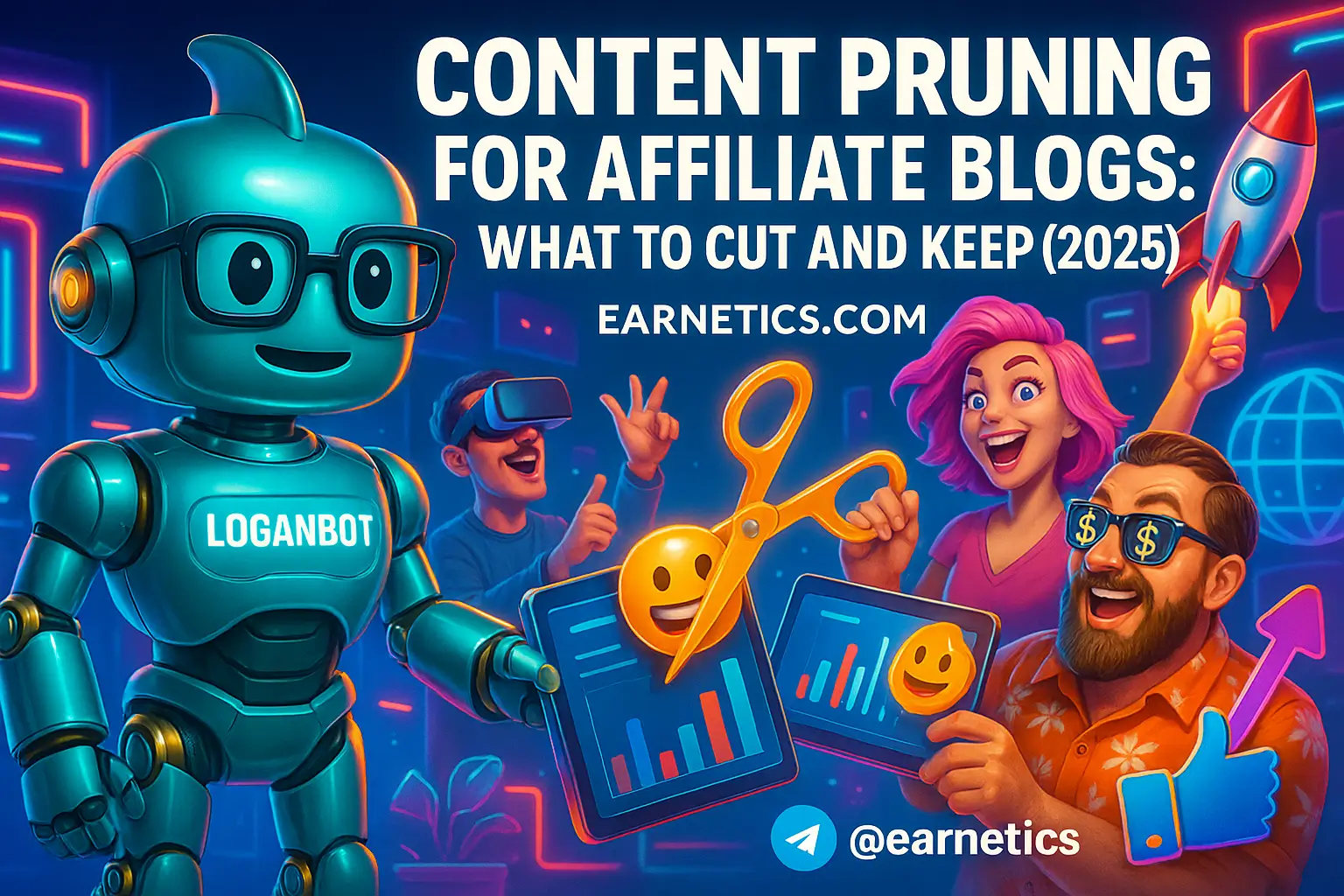How content pruning for affiliate blogs can rescue revenue, speed up sites, and stop traffic leaks in 2025
Content pruning for affiliate blogs saved my site from traffic rot and falling RPMs – a practical, step-by-step audit-to-monitor playbook that protects revenue.
I still remember opening my analytics one toxic Monday and seeing the slow bleed: pages with zero clicks, stale affiliate links, and thin posts dragging down the rest of the site. That’s the context for why content pruning for affiliate blogs matters more than ever in 2025 – algorithm updates, stricter E-E-A-T expectations, and fiercer ad and affiliate competition mean volume without quality is a liability, not an asset.
Here’s the promise: I’ll walk you through the exact process I used to decide what to cut, what to keep, and how to consolidate without nuking recurring revenue. This is hands-on, not academic: audit, cut criteria, consolidation, refresh, then monitor. Do this right and you get higher RPM, less maintenance, and a leaner site that Google actually trusts.
Quick keyword map I used for planning (helpful for your own audit):
Primary keyword – content pruning for affiliate blogs
Secondary keywords – content audit for affiliate blogs, what to prune on affiliate blogs, content consolidation affiliate marketing, optimize affiliate content 2025, affiliate content performance tracking, prune affiliate site content
LSI / related phrases – prune thin pages, merge duplicate content, page-level RPM, affiliate link management, content cannibalization, remove low-value pages, 301 redirect best practices, E-E-A-T updates 2025, site health crawl errors, seasonal product pages
If you’re an affiliate publisher, niche blogger, or SEO manager who’s tired of mediocre CPMs and maintenance hell – this is for you. Expect a clean, repeatable system that protects earnings, reduces clutter, and gives your editorial team something to actually do besides rewriting the same low-value listicles.
Run a Content Audit
Inventory and mapping
I started by exporting everything – URLs, last published date, and whatever revenue data I could pull. If your platform doesn’t expose page-level earnings, get creative – use affiliate platform reports, UTM-tagged links, or server logs. Then I mapped pages into topic clusters and funnel stages – review, comparison, how-to, landing pages – so I could see where the site had duplication or gaps.
Making the inventory felt like cleaning out a junk drawer. I found three vague “best X” posts that targeted the same keyword family, plus half a dozen one-paragraph seasonal pages nobody linked to. Mapping by topic cluster made decision-making a lot faster – you can cut one page per cluster and see the effect, or consolidate similar posts into a single authority guide.
Metrics to gather and prioritize
My audit priority list focused on last 12-month sessions, conversions or transactions, revenue per page, impressions and CTR, backlinks, and crawl errors. I also flagged publish date and target keyword for context. Raw traffic is useful, but conversions and revenue are king for affiliate blogs – a low-traffic page with high conversion deserves protection.
Pro tip: calculate a simple content health score per page: weighted metrics such as traffic (30%), revenue (35%), backlinks (20%), freshness (10%), and technical issues (5%). That gave me a sortable number so I wasn’t making gut calls on every URL.
Tools and quick setup
My stack was boring but reliable: GA4 for behavior and events, Google Search Console for impressions and clicks, Ahrefs for backlinks and keyword data, Screaming Frog or Sitebulb for crawl and indexability checks, and a plain Google Sheet to hold the audit. If you want a faster path, SEMrush also combines several signals, but I prefer separate tools for accuracy.
Set up: export URLs from your CMS, stitch in GA4 and affiliate revenue with UTM or page-path mapping, pull GSC clicks and impressions, then add backlink counts from Ahrefs. If you start with an audit spreadsheet template, you can get actionable results in a day for a small site and a week for a mid-sized network.
Decide What to Cut
Cut, keep, or convert – decision criteria
At this point I had to be ruthless. My cut/keep/convert rubric looked like this: cut pages with no traffic and no links older than 12 months, keep pages with steady conversions or strong backlinks, and convert thin or outdated posts into richer guides if they showed any intent alignment. I scored content quality too – thin, duplicate, or AI-fed fluff got lower marks.
Also consider intent mismatch – a page targeting informational queries that tries to hard-sell a product usually underperforms. And don’t forget compliance – affiliate disclosure issues or outdated claims create legal risk and can tank trust fast.
Options for removal: delete vs 410 vs noindex vs redirect
Not all removals are equal. I used 410 for pure garbage pages that had zero inbound links and zero business value – they can disappear. For pages I planned to merge, 301 redirects to the consolidated URL preserved link equity. For seasonal pages or internal-use content, I applied noindex so Google ignored them without losing internal linking structures.
Decision rule summary: 410 for dead wood, 301 when content merges, noindex for low-value internal or temporary pages, and delete only when you’re sure no tracking or links exist. Always document every change – you will thank yourself later when something weird happens.
Protecting earnings and tracking changes
I flagged pages that drove recurring commissions and excluded them from any immediate deletion plan. For risky removals I scheduled staged rollouts – noindex first, measure impact, then redirect or 410 if metrics stayed healthy. I also double-checked affiliate parameters and tracking tokens so commissions didn’t evaporate during redirects.
Do this wrong and you’ll lose a month of payouts. Do it staged and you learn without bleeding revenue. That’s the difference between a smart prune and a dumb purge.
Consolidate and Merge Pages
Identify cannibalization and overlapping guides
Finding cannibalization saved me weeks of work. I used keyword mapping to find duplicate-intent pages – multiple posts ranking for the same or very similar terms. I prioritized merges where combined traffic plus backlinks would create a single, stronger asset. If two thin reviews were split by brand but targeted identical intent, they became one authoritative review.
Prioritization rule: merge pages with overlapping keywords and at least one reasonable backlink or conversion. If neither exists, it’s probably safe to cut instead of merge.
Merge best practices and technical steps
The merge playbook I followed: pick the strongest URL as the canonical target, copy and combine the best content (don’t just paste everything), craft new H1/H2 structure, and implement a 301 redirect from the old pages. Update internal links sitewide to point to the consolidated article, refresh schema where needed, and submit the updated sitemap to Google Search Console.
Small tactical details matter – preserve paragraph-level context, keep relevant headings, and prune redundant lists. After a merge, monitor impressions and rankings for the next 4 – 8 weeks to catch any unexpected drops.
Preserve affiliate tracking and creative assets
When merging I made sure affiliate tracking parameters survived redirects. That meant testing with real tracking links and ensuring the destination page accepted the query parameters or had server-side handling for click tracking. I also migrated review boxes, comparison tables, and product IDs intact so the user experience stayed consistent.
One time I merged three review posts and forgot to move the comparison table. Conversions tanked for a week before we realized it. Don’t be me – check every creative asset after consolidation.
Update and Optimize What You Keep
Content refresh checklist for conversions and SEO
For the pages I kept, I ran a refresh checklist: update prices and specs, add new test data, reinforce E-E-A-T with fresh author bios and citations, swap in new images, and tighten CTAs. I added structured data for product and review where appropriate and improved page depth with recent user quotes or updated benchmarks.
One refresh example: a 2019 “best headphones” guide regained traffic after I added 2025 models, updated pricing, and inserted a transparent review methodology section. The update signaled relevancy to Google and trust to readers – win-win.
On-page and UX improvements for higher RPM
Higher RPM came from better UX as much as SEO. I improved load speed by lazy-loading images and preloading hero assets, optimized mobile layouts for thumb-friendly CTAs, and made pages skimmable with comparison tables and short pros/cons. I also made affiliate disclosures more obvious and honest – that reduces complaints and increases click-throughs.
CRO wins were often simple: move the primary CTA above the fold on mobile, use clearer button copy, or simplify the comparison table so the recommended product stands out.
CRO and A/B testing after pruning
After pruning I A/B tested CTA placements, button copy, and the recommendation logic. I tracked CTR to the affiliate link and downstream conversions. If a control page lost clicks after pruning, I iterated with micro-experiments instead of reversing the whole prune.
Small experiments compound. A/B test the things that affect revenue most – the hero CTA, the review box layout, or the primary comparison row – and iterate every 2 – 4 weeks.
Monitor Results and Maintain
KPIs to watch after pruning
Once pruning started, I watched traffic, impressions, clicks, conversions, RPM, bounce/engagement, crawl stats, and backlink changes. The short-term metric is impressions and clicks – those show if Google re-crawled your changes and how visibility shifted. Conversions and RPM are the ultimate signals – they tell you if pruning truly improved monetization.
Also watch crawl errors and index coverage in Google Search Console – redirected or noindexed pages sometimes throw unexpected crawl issues that affect other parts of the site.
Reporting cadence and experiment windows
I used a two-tier cadence: short-term checks at 4 – 8 weeks for immediate visibility or traffic shocks, and long-term analysis at 3 – 6 months for revenue, rankings, and backlink recovery. Most positive or negative trends settle into place within three months, but affiliate payouts and seasonal cycles can delay the full picture.
If an experiment fails, roll back the minimal parts – re-enable a page, restore a redirect, or change CTA copy. Don’t panic, iterate.
Ongoing maintenance workflow
Pruning is not one-off. I created a pruning playbook and a quarterly micro-audit schedule. Every page gets a lifecycle label – evergreen, seasonal, test, or archive – and that determines maintenance rhythm. Team roles were clear: editor owns content updates, SEO owns keyword mapping and redirects, dev handles technical changes.
This workflow turned maintenance from reactive chaos into a predictable system. Your team will thank you when they stop rewriting the same junk every month.
Conclusion
Content pruning for affiliate blogs in 2025 is not about killing pages for sport – it is strategic cleanup that boosts revenue per page, improves user experience, and reduces the maintenance load. My practical workflow worked: audit, decide (cut/keep/merge), consolidate, refresh, and monitor. Following that loop made the site leaner and more profitable without sacrificing the occasional winner page that was quietly carrying the business.
Quick action checklist you can copy right now:
1. Run a full content audit and map pages to topic clusters and funnel stages.
2. Tag revenue-critical pages so they are never accidentally removed.
3. Remove or 410 truly dead pages; noindex or redirect the rest as needed.
4. Merge duplicate-intent posts into authoritative guides with 301 redirects.
5. Refresh retained pages with current data, E-E-A-T signals, and better CTAs.
6. Monitor KPIs for 4 – 8 weeks then evaluate at 3 months and iterate.
Risks exist – the biggest is hurting revenue by deleting a hidden winner. Mitigate by staging removals, preserving redirects, and tracking affiliate links and tracking tokens. Also, keep an eye on affiliate program rules and disclosure requirements so you don’t accidentally violate terms when you restructure links or pages.
Next steps: if you want a fast start, use an audit template to collect data, do a mini-prune on a small cluster, and measure. Try tool trials to speed the process, and hire technical help for large redirect projects if needed. If your CMS or site network is big, a specialist for the redirect plan is worth the cost.
🚀 Still curious? When I hit a wall, automation saved me. My hidden weapon is Make.com – and you get an exclusive 1-month Pro for free.
✨ Want the real secret? If this clicked, my free eBook “Launch Legends: 10 Epic Side Hustles to Kickstart Your Cash Flow with Zero Bucks” goes deeper on systems and automation that scale small affiliate sites fast.
If you want templates, tracking sheets, and a simple prune playbook, start with the audit spreadsheet and the tools I mentioned. Build your pruning cadence into the editorial calendar, and treat pruning as continuous optimization – not a one-off purge. For more guides and step-by-step templates, explore more guides on Earnetics.com.
Final note – be conservative, be data-driven, and don’t trash something just because it looks old. Pruning done right is surgical and profitable. Do it carefully, measure everything, and you’ll end up with a site that ranks cleaner and earns harder.


